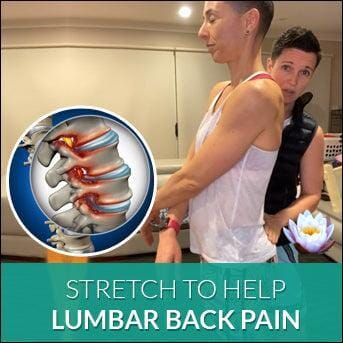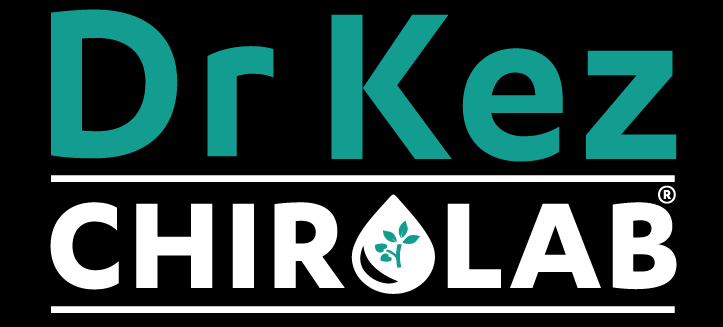
Lumbar disc, Lower back stretches you can do at home!
In the video
- 00:59 - Introduction & Patients story
- 01:54 - Difficulty we face
- 02:45 - Why do we get back pain?
- 03:47 - What is the solution?
- 06:56 - About Stretching
- 07:51 - How to achieve the best stretch?
- 11:29 - Abdominals and our buttock muscles
- 12:18 - A simple test to see if this is your issue
- 15:50 - Chat session with Audience
00:59 - Introduction & Patients story
More often than not a lumbar disc injury is the result of an incident that involves a heavy lifting and twisting incident. In the case of this patient, his lumbar disc damage was not caused in this way. There was no event that suddenly damaged his disc. The issue was a slowly progressing, long-term issue that finally led to an MRI that revealed significant lumbar disc degeneration. In his case, it was the result of ongoing postural abnormalities that have predisposed the disc to damage. When faced with biomechanical imbalances, for a prolonged period of time, our spine and discs can begin to degrade, which is what happened in this patients case. The resultant disc injury, however ends up causing the same concerns.
Almost everyone spends a significant amount of time sitting at a desk or on a couch, which contributes to postural imbalance. When we sit for long periods of time, our hip flexors shorten, causing the same imbalance that precipitated this patients lumbar disc condition.

01:54 - Difficulty we face
The important thing is that we have to consider each patient's circumstances carefully and view their body as a whole, with all of the biomechanical features taken into account. Looking at a lumbar disc injury, without considering the postural imbalances that lead to the issue in the first place may result in a treatment that is unsuccessful or significantly drawn out.
02:45 - Why we get back pain?
Sitting for much of our day results in tightened hip flexors. These hip flexors attach to the femur (thigh bone) and the spine. As a result of being shortened, when we go to stand up this muscle pulls on the front of the lumbar spine, resulting in a significantly increased lumber curve, which we call a hyperlordosis. This can be quite obvious in some people who present with a noticeable sway back or their bottom looks like it extends out more than normal. When you have a hyperlordosis, the weight of your whole torso, head, shoulders, arms etc. isn't distributed where it should be and it ends up forcing your discs into vulnerable positions that can then result in a lumbar disc herniation.
Our discs are made to support our upper body weight and resist impact. They are made up of a tooth-paste like gelatinous material in the middle (nucleus pulposus) to achieve this shock absorbing ability and a fibrous outer layer (annular fibres) that resist rupture. When imbalances occur in the lower body, the pressure placed on these vulnerable discs increases resulting in sensitive pain fibres being activated and pain and inflammation ensuing.
03:47 - What is solution?
This problem, which is caused by a tight hip flexor, can be solved by stretching it. This hip flexor muscle (psoas), shortens when you sit for a lengthy amount of time, so it is important to spend dedicated time stretching it to allow it to go back to it's desired length, so that it doesn't remain tight and then pull your lumbar spine into this excessive curve that makes the discs extremely vulnerable. Although in this example on Em, I exaggerate the excessive curve, in reality it only takes a few extra degrees of lumbar curve to result in vulnerability to your discs. So the extent of the excess curve can occur in various degrees in different people, from having a really noticeable sway back with your bottom noticeably sticking out like a ducks bum, to it not being obvious at all to an untrained eye. Let me make it clear, if you spend a large proportion of your day sitting, this issue will be present in some degree or another. Now that we've figured things out, let's loosen up that hip flexor.
06:56 - About Stretching
If you completed one stretch a day, your muscles would benefit. If you're doing this stretch, people sometimes lean their entire body forward when they first start. Keep in mind that this muscle is attached to your lumbar spine. You must maintain your body and posture upright to stretch it, almost like you are leaning your torso backwards. When you lunge forward, your hip flexor will start to stretch, to further stretch it effectively, tuck your pelvis in and under. If you're leaning forward, you'll need to push your pelvis forward a little. A tilt of the pelvis underneath can really isolate this hip flexor muscle and stretch it even more effectively.

07:51 - How to achieve the best stretch?
- Hip flexor stretch - Keep your spine upright, relax your bottom, and allow your pelvis to tilt backwards to get the optimum stretch. Make sure you don't allow your front knee to extend over your toes, as this can cause knee damage, if this is happening take a longer step forward with your front foot to ensure that your knee doesn't extend past your toes. Maintaining a straight spine is critical. It can make a huge impact in terms of back discomfort. Be cautious if you have SI joint problems or widespread lumbar discomfort, or if you already have disc damage. That's it for the first stretch.
- Lower back muscle stretch - The lumbar spine will be stretched out as the step. Tucking your legs to your chest while lying on your back helps enhance blood flow to your lower back. Pulling your knees up and opening the lumbar spine in this way brings your spine in the opposite direction that has been occurring with the excessive lumbar curve. This takes pressure off the disc and gives them a chance to move back into a more optimal position. The lumbar spinal muscles that have been tight, are also given an opportunity to stretch in this position. This is accomplished by raising the knees to the chest and allowing the lumbar spine to open up. After you've held your knees to your chest for approximately 1 minute, the blood flow will have significantly improved and it is time to bend both knees slowly to one side, keep your arms outstretched to your side, like a crucifix and make sure your shoulder stays on the floor, to give the lower back a good stretch. It is important not to do this twisting movement too fast, as you do not want the spine to crack. Hold this position for a further minute and then slowly bring your knees back up the the middle and then gently and slowly down to the other side, keeping the motion slow and your shoulder on the floor for a further minute.

Our abdominals and buttock muscles must be strengthened with this postural imbalance also. Our abdominals and our gluteal muscles have the ability to tilt our pelvis in the right direction to decrease this excessive lumbar curve. After doing your stretching of the lumbar spinal muscles and the tight hip flexors, it is time to strengthen the and and glutes to keep the pelvis in the optimal position to reduce the lumbar curve and take pressure off the lumbar discs.
If your lower back is aching while you're standing in the supermarket queue or while you're doing the dishes, it is very likely that this exact postural imbalance that we have been discussing is happening to you. Try this test, when your back gets sore whilst standing - tuck your pelvis under by contracting your glutes and abs. This will right the excessive lordosis temporarily and take pressure off the facet joints in your back and alter the disc orientation. If this reduces the pain, or takes it away altogether, you have definitely confirmed that exactly what we are talking about is your issue and the series of stretches and exercises we're performing in this video, is exactly what you need to correct the problem. This postural misalignment affects about 90% of the population.
12:18 - Strengthening your abs and glutes

Hip bridges are the best way to strengthen your glutes (see the picture above). The objective is to contract your glute muscles to raise your pelvis up until it is flat. It's vital to remember that if you can pinch that muscle just a little bit more when you get your body flat, that last five degrees of movement, makes the world of difference to being able to correct this postural imbalance. Working on all of these stretches and exercises will help to resolve this postural imbalance quickly, helping your disc problem to repair, giving you the ability to take on the rest of the world.
There are three types of abdominal muscles involved in our abs as a whole. We're working on the washboard or six-pack abs, for the purpose of helping to tilt the pelvis in the right direction and rectify the pelvic imbalance that leads to disc injuries. The rectus abdominus muscle needs to be worked on from the top and bottom aspect, bringing the ribs to the pelvis works the top, and bringing the pelvis to the ribs works the bottom. Once this muscle has been activated effectively by the exercises shown in this video, they will be more inclined to hold the pelvis in the appropriate orientation to rectify this issue.15:50 - Chat session with Audience
Interacted with Live Audience and solved their queries.







